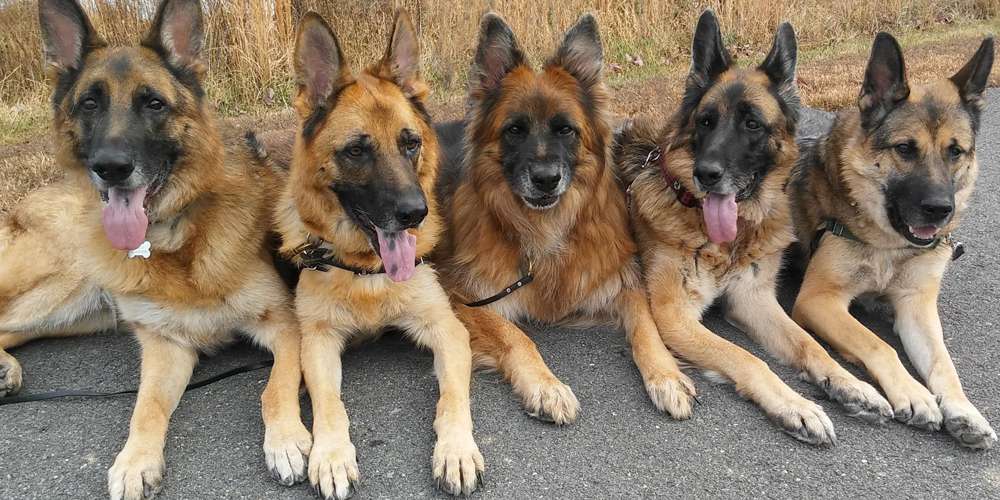
Positive Reinforcement:
The dog’s behavior makes something good happen. “Positive”, in behavioral terms, means something is added. “Reinforcement” means the behavior increases. When your dog sits, you feed him a treat. His behavior (sitting) made something good happen, something was added (the treat). As a result, your dog is more likely to offer to sit again, so the behavior increases. Positive trainers use positive reinforcement a lot.
Positive Punishment:
The dog’s behavior makes something bad happen. (Positive means something is added, punishment means the behavior decreases.) Example: When your dog jumps on you you knee him hard in the chest. He gets off. His behavior (jumping up) made something bad happen; something was added (your knee in his chest). As a result, your dog is more likely to think twice before jumping on you again. “Positive trainers” do not use positive punishment very much, if at all.
Negative Reinforcement:
The dog’s behavior makes something bad go away. (Negative means something is taken away; reinforcement increases the behavior.) Example: A trainer wants a dog who is lying down to sit. He pulls the dog’s leash upward, tightening the collar. When the dog sits up, the trainer slacks the leash. The dog’s behavior (sitting) makes the bad thing (the tightened collar) go away. Positive trainers may use a limited amount of negative reinforcement in the form of mild physical pressure, or sub-threshold presentation of an aversive stimulus (CAT).
Negative Punishment:
The dog’s behavior makes something good go away. (Negative = something is taken away; punishment = the behavior decreases.) When your dog jumps up, you turn your back and step away. His behavior (jumping) made something good (your attention) go away. Positive trainers use negative punishment as a mild negative consequence for unwanted behavior.
Positive Reinforcement Training
“Learning Theory” is a discipline of psychology that explains how an organism learns. It consists of many different theories of learning, including instincts, social facilitation, observation, formal teaching, memory, mimicry, and classical and operant conditioning. It is these last two that are of most interest to many animal trainers.
Why should animal trainers be bothered with learning the theory behind how their animals learn? When one understands how an animal learns, it is much easy to train and solve behavioral issues.
Classical or “Pavlovian” Conditioning:
Classical Conditioning is the type of learning made famous by Pavlov’s experiments with dogs. The gist of the experiment is this: Pavlov presented dogs with food, and measured their salivary response (how much they drooled). Then he began ringing a bell just before presenting the food. At first, the dogs did not begin salivating until the food was presented. After a while, however, the dogs began to salivate when the sound of the bell was presented. They learned to associate the sound of the bell with the presentation of the food. As far as their immediate physiological responses were concerned, the sound of the bell became equivalent to the presentation of the food.
Classical conditioning is used by trainers to create an association between a stimulus that normally would not have any effect on the animal and a stimulus that would. Generally it is used to make a positive association.
Operant Conditioning:
Operant conditioning forms an association between a behavior and a consequence. (It is also called response-stimulus or RS conditioning because it forms an association between the animal’s response [behavior] and the stimulus that follows [consequence]).
There are four possible consequences to any behavior. They are:
- Something Good can start or be presented;
- Something Good can end or be taken away;
- Something Bad can start or be presented;
- Something Bad can end or be taken away;
Consequences have to be immediate, or clearly linked to the behavior. With verbal humans, we can explain the connection between the consequence and the behavior, even if they are separated in time. For example, you might tell a friend that you’ll buy dinner for them since they helped you move, or a parent might explain that the child can’t go to summer camp because of her bad grades. With very young children, humans who don’t have verbal skills, and animals, you can’t explain the connection between the consequence and the behavior.
Technical Terms:
The technical term for “an event started” or “an item presented” is positive, since it’s something that’s added to the animal’s environment.
The technical term for “an event ended” or “an item taken away” is negative, since it’s something that’s subtracted from the animal’s environment.
Anything that increases a behavior – makes it occur more frequently, makes it stronger, or makes it more likely to occur – is termed a reinforcer. Often, an animal (or person) will perceive “starting Something Good” or “ending Something Bad” as something worth pursuing, and they will repeat the behaviors that seem to cause these consequences. These consequences will increase the behaviors that lead to them, so they are reinforcers. These are consequences the animal will work to attain, so they strengthen the behavior.
Anything that decreases a behavior – makes it occur less frequently, makes it weaker, or makes it less likely to occur – is termed a punisher. Often, an animal (or person) will perceive “ending Something Good” or “starting Something Bad” as something worth avoiding, and they will not repeat the behaviors that seem to cause these consequences. These consequences will decrease the behaviors that lead to them, so they are punishers.
Applying these terms to the four possible consequences, you get:
- Something Good can start or be presented, so behavior increases = Positive Reinforcement
- Something Good can end or be taken away, so behavior decreases = Negative Punishment
- Something Bad can start or be presented, so behavior decreases = Positive Punishment
- Something Bad can end or be taken away, so behavior increases = Negative Reinforcement
